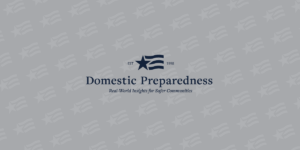

Modern Responses to Today’s Disasters
Catherine L. Feinman
October 31, 2018
Disaster plans of previous generations do not adequately reflect the risks, threats, and needs of
modern society. Changing demographics, aging populations, and increasing natural and human-caused
disasters each reinforce the need for emergency and disaster preparedness professionals to gain the
knowledge and training needed to make informed decisions to mitigate threats and execute effective
responses when mitigation is not enough.

Helping the Chronically Ill During Natural Disasters
Allegra Balmadier
October 24, 2018
Although 2017 was a historic year for natural disasters, 2018 is turning out to be more of the same. Filled with wildfires, tornadoes, floods, tropical systems, and the devastating Hurricanes Florence and Michael, it appears the frequency of natural disasters is increasing. Preparedness professionals face challenges meeting the needs of everyone impacted by such events, especially those with chronic conditions. Fortunately, with pre-disaster planning and post-disaster recovery and evaluation, preparedness professionals can better help the most vulnerable access the resources they need.

The Opioid Crisis & Its Impact on Public Safety
Catherine L. Feinman
October 17, 2018
The United States is in the midst of an epidemic of addiction to opioids and fentanyl. On 18
September 2018, DomPrep hosted a roundtable discussion at MedStar NRH Rehabilitation Network in
Washington, DC, to discuss this threat. The three-hour conversation led by Craig DeAtley, PA-C,
emergency manager for MedStar System, examined the extent of the problem, including the harmful risks to
operational responders – people who are in physical contact with people as part of their daily work –
from fentanyl/opioid exposure. Key discussion points summarized in this article included: impacts on
public safety, data collection, best practices, personnel protection, and whole community collaboration.

The Value of Knowledge & Training in Response Operations
Anthony S. Mangeri
October 10, 2018
In today’s emergency service professions, it is essential to master the core knowledge necessary to understand the research and emerging technology that guide incident response. To become truly prepared to respond, each emergency professional must take the time to develop the knowledge to manage the threat and initiate response operations. Training and education are critical in helping a responder master the competencies needed for response efforts.

Active Threat Response in Nashua, New Hampshire
Mark Hastings
October 3, 2018
Prior to 2013, the active threat plans in Nashua, New Hampshire (NH), consisted of separate
responses by law enforcement, fire, and emergency medical services (EMS). There was no coordinated plan.
Involvement with area hospitals was not considered other than receiving patients. The Nashua Police SWAT
Team and the Nashua Office of Emergency Management recognized this gap. This case study shares this
city’s solution for creating and testing an integrated active threat “one plan” (the integration of
several previously existing plans).

Special Edition: School Security
Robert Boyd
October 2, 2018
In 2017, the Secure Schools Alliance (the Alliance) began a unique relationship with the DomPrep Journal. The goal was to raise awareness of the need to improve K-12 school security within the emergency preparedness community. This special reprint edition is a compilation of this effort, beginning with the macro argument of why school security needs to be improved and concluding with a call to recognize that schools are a critical part of the nation’s crumbling infrastructure, which has been ignored for way too long.

